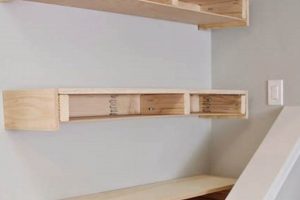The creation of an optical illusion using mirrors and light-emitting diodes (LEDs) to produce the visual effect of a seemingly endless tunnel of light is a popular project. This involves constructing a frame, typically from wood or plastic, and fitting it with a partially reflective mirror on the front and a fully reflective mirror on the back. LEDs are placed around the perimeter, between the two mirrors, creating the illusion of depth. A simple example would be a coffee table where the surface appears to be a deep, illuminated void, rather than a solid tabletop.
This form of creative construction offers numerous benefits, ranging from enhanced understanding of optical principles to the acquisition of practical crafting skills. The endeavor fosters problem-solving abilities, as builders must overcome challenges related to wiring, mirror alignment, and light diffusion. Historically, the underlying principles of light reflection have been explored in scientific and artistic contexts for centuries, while the application of modern LEDs enables unique and accessible projects.
The following sections will delve into the required materials and tools, provide step-by-step instructions, and offer tips for customizing these unique illuminated displays. Considerations for safety and troubleshooting common issues will also be addressed, ensuring a successful and enjoyable building experience.
Essential Considerations for Infinity Mirror Construction
Successful creation of an infinity mirror requires careful attention to detail and adherence to best practices. These guidelines are intended to optimize the building process and enhance the final product’s aesthetic and functional qualities.
Tip 1: Select High-Quality Mirrors: Partial mirrors, also known as two-way mirrors, are crucial for the infinity effect. Ensure the reflective coating is evenly distributed to avoid distortions. Back mirrors should be of standard quality and free from imperfections.
Tip 2: Plan the LED Layout: Determine the number of LEDs and their spacing based on the desired brightness and evenness of illumination. Consider using LED strips with adhesive backing for ease of installation and uniform light distribution.
Tip 3: Properly Diffuse the Light: Direct LED light can appear harsh and create distinct points of light. Employ diffusion methods such as frosted acrylic or light-diffusing film to achieve a softer, more uniform glow throughout the reflective space.
Tip 4: Secure Wiring Connections: Ensure all electrical connections are properly soldered and insulated to prevent short circuits or potential hazards. Use appropriate gauge wiring to handle the current load of the LEDs.
Tip 5: Calibrate Mirror Alignment: Precise alignment of the partial and back mirrors is essential for maximizing the depth and clarity of the infinity effect. Use shims or adjustable mounts to fine-tune the mirror positioning.
Tip 6: Utilize a Robust Power Supply: Choose a power supply with sufficient wattage to power all the LEDs without straining the unit. A regulated power supply will ensure consistent brightness and prevent premature LED failure.
Tip 7: Consider a Back Panel for Protection: Add a solid back panel to protect the internal components, such as wiring and the back mirror. This also provides a clean and finished look to the project.
By following these guidelines, individuals can significantly improve the quality, durability, and visual appeal of their projects. Attention to these details will contribute to a more satisfying and long-lasting outcome.
The subsequent section of this guide will offer a comprehensive list of frequently asked questions, addressing specific concerns and providing additional insights for successful mirror construction.
1. Mirror Quality
Mirror quality exerts a significant influence on the visual fidelity and overall effectiveness in the construction of infinity mirrors. The reflective properties of the mirrors directly determine the perceived depth and clarity of the illusion. Imperfections in the mirror surface, such as scratches, distortions, or inconsistent coatings, introduce artifacts that detract from the intended effect. For instance, a flawed partial mirror can create multiple reflections or ghosting, disrupting the seamless appearance of receding light. Similarly, imperfections on the back mirror will be amplified through repeated reflections, leading to a degraded visual experience. Therefore, selecting mirrors of high optical quality is essential for maximizing the immersive effect.
The choice between glass and acrylic mirrors also impacts the final outcome. Glass mirrors typically offer superior reflectivity and durability but are more prone to breakage. Acrylic mirrors are lighter and more impact-resistant but may exhibit slight distortions, particularly in larger sizes. Furthermore, the type of reflective coating affects the mirror’s ability to transmit light. A partial mirror with an inadequate coating will allow too much light to pass through, diminishing the infinity effect. In practical terms, investing in high-quality mirrors minimizes visual artifacts and maximizes the illusion of depth, creating a far more compelling and convincing effect.
In summary, mirror quality stands as a foundational element in achieving a convincing infinity mirror. Compromising on mirror quality leads to a diminished illusion and detracts from the overall aesthetic appeal. Careful selection and handling of high-quality mirrors are crucial for realizing the intended visual effect. While challenges associated with cost or availability may arise, the long-term benefits of superior mirror quality justify the investment in creating a truly captivating infinity mirror.
2. LED Density
In the context of infinity mirror construction, LED density refers to the number of light-emitting diodes per unit length or area within the enclosed space between the mirrors. This parameter directly influences the brightness, uniformity, and overall visual effect of the illusion. A lower density can result in dark spots and uneven illumination, detracting from the seamless appearance of receding light. Conversely, an excessively high density can lead to over-saturation, reducing the perceived depth and increasing power consumption. The correct density is thus a critical factor in achieving a balanced and convincing effect.
The selection of an appropriate LED density must consider the size and shape of the mirror, the reflective properties of the mirrors used, and the desired aesthetic outcome. For smaller projects, a moderate density of LEDs may suffice. However, larger projects necessitate a higher density to maintain consistent brightness throughout the reflective space. Furthermore, different types of LEDs emit varying levels of light, influencing the density required to achieve a specific level of illumination. As an example, an infinity mirror buil
t with 30 LEDs per meter of strip may appear adequately lit, whereas a similar construction using less luminous LEDs might require 60 or more LEDs per meter. An insufficient LED density results in visible gaps and disrupts the illusion, while an overabundance of LEDs can create a harsh or glaring appearance.
Optimal LED density is a crucial aspect in realizing the illusion of infinite depth. Selecting the appropriate density requires careful consideration of the project’s dimensions, LED characteristics, and desired brightness. A balanced approach ensures even illumination, a visually pleasing effect, and efficient power usage. While experimentation may be necessary to determine the ideal density for a given configuration, understanding the fundamental relationship between LED density and the visual outcome is essential for successful mirror fabrication.
3. Power Supply
The power supply represents a critical component in the successful implementation of any infinity mirror project. It serves as the energy source for the light-emitting diodes (LEDs) that generate the illusion of depth. A properly specified power supply ensures consistent and reliable operation, while an inadequately chosen unit can lead to diminished brightness, flickering, or even complete failure of the illumination system. As a result, the selection and integration of an appropriate power supply directly impact the final aesthetic and functional outcome of the project.
The connection between power supply and the desired lighting effect is best illustrated through examples. For instance, a small, USB-powered infinity mirror designed for desktop use may require a 5V power supply with a current rating of 1 Ampere. Conversely, a larger infinity mirror integrated into a coffee table or wall art installation might necessitate a 12V power supply with a current rating of 5 Amperes or higher, depending on the number and type of LEDs employed. Failure to match the power supply’s voltage and current capacity to the LED requirements can result in reduced light output, uneven illumination, or premature failure of the LEDs. Moreover, the power supply must be selected to accommodate the total power consumption of the LEDs, accounting for any additional circuitry or components within the mirror design. In each example, choosing the right power supply ensures that the LEDs receive the necessary voltage and current to operate efficiently and effectively.
In conclusion, the power supply acts as the foundation for a functional and visually appealing infinity mirror. The selection of a power supply capable of delivering the required voltage and current to the LEDs is non-negotiable. Failure to do so results in unsatisfactory performance. While seemingly a straightforward component, its appropriate selection is critical to ensure the longevity, brightness, and overall success of the project. Potential challenges include calculating the precise power requirements and selecting a reliable power supply from the many available options. Nonetheless, addressing these challenges is imperative for creating a compelling and enduring infinity mirror.
4. Frame Construction
Frame construction forms an indispensable element in the successful execution of an infinity mirror project. It provides the structural support for all other components, including the mirrors, light-emitting diodes (LEDs), and power supply. The frame’s rigidity ensures proper alignment of the mirrors, a critical factor in achieving the illusion of infinite depth. Improperly constructed or insufficiently robust frames can warp or flex, leading to misalignment and a distorted visual effect. For example, a frame built from thin, unbraced wood may bow under the weight of the mirrors, compromising the integrity of the illusion. Similarly, a frame that is not perfectly square can cause the reflections to appear skewed or uneven. Therefore, the frame acts as the foundational backbone of the entire assembly, directly affecting both its aesthetic appeal and its functional performance.
Material selection and construction techniques are paramount. Wood, metal, and rigid plastics represent viable options, each offering varying degrees of strength, workability, and aesthetic qualities. Wood frames require precise cutting and joinery to ensure structural stability. Metal frames, while offering superior strength, demand specialized tools and techniques for fabrication. Plastic frames are lightweight and relatively easy to work with, but may lack the rigidity necessary for larger projects. Regardless of the material chosen, proper bracing and reinforcement are crucial to prevent warping or flexing over time. For instance, reinforcing corners with gussets or adding cross-braces to larger frames significantly enhances their structural integrity. The method of securing the mirrors and LEDs within the frame also merits careful consideration. Recessed channels or retaining clips provide a secure and aesthetically pleasing solution, preventing the components from shifting or becoming dislodged.
In summary, the frame serves as more than just a cosmetic enclosure. It provides essential structural support and ensures proper alignment of the critical optical elements. The choice of materials and construction techniques profoundly affects the durability, stability, and overall quality of the final product. While challenges arise in selecting appropriate materials and executing precise joinery, addressing these challenges is essential for creating an enduring and visually compelling infinity mirror. The construction of the frame directly influences the operational and esthetical parameters.
5. Wiring Safety
Wiring safety is an essential aspect in the construction of an infinity mirror. Improper wiring practices pose significant electrical hazards, including the risk of short circuits, electrical shocks, and fire. The cause-and-effect relationship is direct: inadequate insulation or loose connections create pathways for unintended current flow, leading to overheating and potential ignition of surrounding materials. In an infinity mirror, LEDs are often arranged in close proximity within a confined space, increasing the concentration of electrical components and the severity of potential incidents. A lack of proper wiring also leads to malfunctionality such as LED’s malfunctioning.
The importance of wiring safety extends beyond personal well-being. Correct wiring not only protects the builder but also safeguards the longevity and reliability of the mirror itself. Properly executed connections minimize voltage drops and ensure consistent illumination across all LEDs. A real-life example involves the use of undersized wiring, which can overheat due to excessive current flow, causing the insulation to melt and creating a short circuit. Furthermore, the practical significance of understanding wiring principles lies in the ability to identify and mitigate potential hazards before they materialize. For instance, using appropriate wire gauges, soldering connections securely, and encasing exposed wiring in insulating materials are essential preventative measures. Such a thing not only increases safety but makes the product more trustworthy.
In conclusion, wiring safety is a non-negotiable aspect in the process. Neglecting these principles introduces risks
that far outweigh any perceived time or cost savings. Challenges may arise in understanding complex electrical circuits or sourcing suitable materials, however, these challenges must be overcome to ensure a safe and enjoyable building experience. Prioritizing safe wiring practices not only minimizes the risk of accidents but also contributes to the creation of a durable and visually appealing infinity mirror. It is one of the most important aspects of this project and one that cannot be forgotten.
6. Light Diffusion
Light diffusion constitutes a critical element in the design and functionality of infinity mirrors. The quality and characteristics of light emitted by the LEDs directly influence the visual outcome of the infinite tunnel effect. The use of proper diffusion techniques serves to mitigate harshness, eliminate point source glare, and create a more uniform and visually appealing result.
- Uniformity of Illumination
Effective diffusion minimizes the visibility of individual LEDs, creating a seamless band of light within the reflective space. This uniformity is essential for achieving a convincing illusion of depth. Without diffusion, the light appears as a series of distinct points, diminishing the infinite effect. The use of frosted acrylic sheets placed in front of the LEDs, for example, scatters the light, resulting in a more homogeneous and diffused glow.
- Reduction of Glare
Direct, undiffused LED light can be uncomfortably bright and create distracting glare. Diffusion techniques soften the light, reducing eye strain and enhancing the overall viewing experience. The application of light-diffusing film, which scatters the light in multiple directions, effectively reduces glare. Direct bright light is not the kind of look you would want in your home’s esthetic.
- Enhancement of Color Mixing
In infinity mirrors that utilize RGB (Red, Green, Blue) LEDs to produce a range of colors, diffusion plays a crucial role in blending the individual colors into a smooth and unified spectrum. Without diffusion, the individual red, green, and blue light sources remain distinct, resulting in a fragmented color appearance. Light diffuser blend these three colors to create more natural and appealing tones.
- Minimizing Reflections of LED Components
In the absence of sufficient diffusion, reflections of the LEDs and associated wiring can become visible within the mirrors, disrupting the illusion of infinite depth. Diffusion techniques obscure these components, maintaining a cleaner and more seamless visual effect. Light diffuser prevent reflections in a way that it allows the user to focus on the visual effect created in the mirrors.
The success of an infinity mirror depends significantly on the effective implementation of light diffusion. Without proper diffusion, the visual effect suffers from uneven illumination, harsh glare, and visible LED components. A well-diffused light source creates a more immersive and visually pleasing experience, enhancing the overall quality and realism of the illusion. This can enhance the overall experience of the user and enhance the appeal of the product.
7. Mirror Alignment
Precise mirror alignment constitutes a fundamental aspect of infinity mirror construction, directly impacting the quality and persuasiveness of the illusion created. Deviations from perfect parallelism introduce distortions and disrupt the intended visual effect. The overall success of such project hinges upon the accurate positioning of the mirrors relative to one another.
- Parallelism of Reflective Surfaces
The two mirrors, typically a partially reflective mirror and a fully reflective mirror, must be precisely parallel to each other. Even slight angular misalignments result in skewed reflections and a non-uniform appearance of depth. For example, a 1-degree difference in angle between the mirrors causes reflections to progressively diverge, disrupting the illusion of a continuous tunnel. This is important in the illusion of light.
- Centering of the Reflective Area
The reflective area of both mirrors should be perfectly centered within the frame or housing. Off-center placement introduces asymmetry and distorts the perceived location of the vanishing point within the infinity effect. An example of this would be that light would be off center.
- Surface Flatness and Mounting Stability
Mirror alignment assumes flat and stable surfaces. Warped mirrors or unstable mounting systems introduce localized distortions that ripple through the reflections. Such warping affects the viewer experience. Sturdy mounts are important for the product to last.
- Tolerance Accumulation and Adjustment
Even if mirrors are perfectly manufactured and placed, small tolerance differences can accumulate and negatively impact the quality of the infinite effect. This means that it is very important to adjust the mirror placement after it is mounted and tested. Minor imperfections will create a negative visual effect.
In sum, mirror alignment is a non-trivial concern in achieving the desired infinite tunnel effect. While challenges are present, the quality will speak for itself. Precise adjustments will contribute to the visual product.
Frequently Asked Questions about Infinity Mirror Construction
The following section addresses common inquiries regarding the construction of infinity mirrors. These questions and answers aim to provide clarity and guidance to individuals undertaking such projects.
Question 1: What is the optimal type of adhesive for securing mirrors to the frame?
Neutral-cure silicone adhesives are generally recommended for bonding mirrors to various frame materials. Unlike acid-cure silicones, neutral-cure formulations do not release corrosive byproducts that can damage the reflective coating on the mirror. Additionally, ensure the adhesive is specifically designed for mirror applications to guarantee long-term adhesion and prevent degradation of the mirror backing.
Question 2: How is uniform illumination achieved with LED strips?
Consistent illumination requires careful selection and placement of LED strips. High-density LED strips, featuring a greater number of LEDs per unit length, mitigate the appearance of individual light sources. Additionally, incorporating a diffuser material, such as frosted acrylic or light-diffusing film, between the LEDs and the reflective surface further enhances uniformity by scattering the light and minimizing hot spots.
Question 3: What safety precautions are necessary when working with electrical components?
Adherence to basic electrical safety practices is paramount. Ensure all electrical connections are properly insulated to prevent short circuits and potential shocks. When soldering wires, utilize a well-ventilated area and wear appropriate eye protection. Furthermore, always disconnect the power supply before making any adjustments or modifications to the wiring.
Question 4: How does the reflectivity of the partial mirror affect the infinity effect?
The reflectivity of the partial mirror directly influences the perceived depth and brightness of the effect. A
mirror with higher reflectivity creates a more intense illusion but may reduce the overall transmission of light. Conversely, a mirror with lower reflectivity allows more light to pass through but diminishes the perceived depth. The optimal reflectivity value is a matter of balance and aesthetic preference.
Question 5: What steps are involved in troubleshooting a non-functional infinity mirror?
Troubleshooting typically involves systematically checking each component. Begin by verifying the power supply is delivering the correct voltage and current. Next, examine all wiring connections for any loose or broken wires. If individual LEDs are not illuminating, test them with a multimeter to determine if they are defective. Finally, inspect the mirror surfaces for any damage or misalignment.
Question 6: How can the longevity of LEDs be maximized in an infinity mirror application?
Extending the lifespan of LEDs necessitates managing their operating temperature. Avoid overdriving the LEDs by ensuring the power supply voltage and current are within the manufacturer’s specifications. Additionally, providing adequate ventilation or heat sinking can help dissipate heat and prevent premature LED failure. It is highly recommended to always follow the manufacturer’s documentation.
In summary, successful infinity mirror construction requires meticulous attention to detail, a thorough understanding of electrical safety, and careful selection of components. By addressing these common questions and concerns, builders can increase their chances of a successful and satisfying outcome.
The subsequent article will delve into advanced customization techniques, exploring options for incorporating programmable LEDs, interactive elements, and unique frame designs to further personalize and enhance the infinity mirror experience.
Conclusion
This exploration has provided a comprehensive overview of the construction of infinity mirrors, highlighting essential considerations for material selection, assembly techniques, and safety protocols. The interplay between mirror quality, LED density, power supply stability, frame integrity, wiring safety, light diffusion, and mirror alignment dictates the final aesthetic and functional properties. Addressing potential challenges through meticulous planning and execution remains paramount.
Future advancements in materials and lighting technologies will undoubtedly introduce new possibilities for this unique form of illuminated art. Continued innovation will drive further refinement of construction methods and enhance the potential for creative expression. It is incumbent upon those engaging in infinity mirror DIY to prioritize safety and craftsmanship, ensuring the creation of durable and visually compelling objects.







